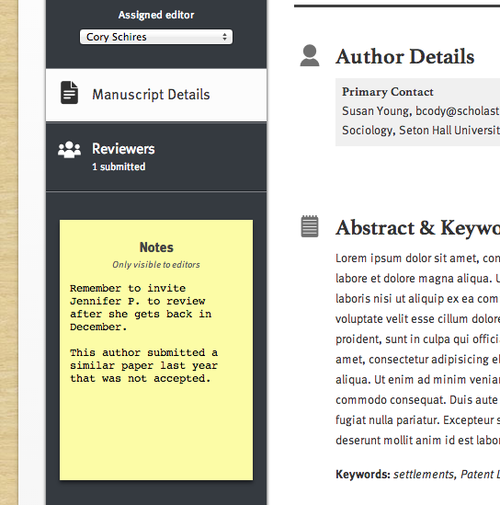
This post is responding to the question: “Hey, why isn’t Scholastica open source?”
To answer this, you need to know three simple truths about Scholastica that the rest of this post elaborates on:
- We love open source – but love open access (OA) even more.
- We care more about substantively improving scholarly publishing than popular buzz words.
- We’re a small team of scholars trying to do something special.
When does open source work?
The ideal environment for open source to work is
- Software with widespread use (think text processing, photo editing, etc.) or is a core programming tool (e.g. Linux, PHP, Ruby on Rails, etc.)
- Audience naturally includes large number of developers/programmers
- Millions of jobs that support on-the-clock contributions (think web designers contributing to WordPress as they build client websites)
Most of the great open source software are meant for widespread use: Linux, PHP, jQuery. By being applicable to millions (or billions) of potential users, their ecosystem of potential contributors is suitably large so that if only 0.001% of users contribute code, the project still grows and can improve over time. Also, if the tool is meant for programmers, the user base has the skills to contribute.
We don’t think that scholarly publishing meets these criteria. There are a few million people involved in contributing research, but vastly fewer who actually serve as editors of journals and hence are the real users of such software. Similarly, while there are many scholar-programmers, most scholars are not Ruby or Python programmers, so the number of contributors becomes very very small and would not realize the potential of open source with tens of thousands of active contributors really growing the product.
**What are the downsides to open source?
**
- User experience and design suffer. I think it’s hard to argue that open source Linux is easier to use for the average person than private software like, say, Apple’s Lion OS or Windows 9. Linux is great for coding, but OS X and Windows are clearly easier to use for most people.
- Difficult to maintain quality. As noted in a Tech Republic article about Linux: “For certain, there is nothing wrong with the open source model, and its use surely helps advance new ideas in software development. As a business model and a model for end-user products, though, it’s less reasonable. Here, it causes a lack of standardization. Egos among the different developers collide, and the final product suffers. Let’s not forget the old adage ‘Too many cooks spoil the broth.’”
- Installation and hosting is a hidden but substantial cost, and open source software takes time to setup and manage.
- Adding new features (development) requires either staff time or paid contractors, plus the time to specify and manage the development of the features you want.
- Troubleshooting tech problems relies on the goodwill of the community, rather than being someone’s job to answer you immediately.
- Potential unfulfilled. If you don’t have a robust community contributing to the code, the project does not improve. Also, you quickly have non-techie users bombarding the small group of developers with troubleshooting problems and creating a negative sense among the community about the software – so that people will look to products that deliver the quality they want.
Different strokes for different folks
Open source is great for programmers, organizations with IT staff who have some bandwidth to customize products, and people who want to control their code. I’m one of those people.
That said, most scholars simply do not fit those criteria and so open source software is not the perfect solution for them. Scholastica decided that there is a genuine need for journal infrastructure that is powerful and easy to use for editors who just want to use the system and don’t want to put time into maintaining it and don’t have the skills to contribute to the code base.
Much of the non-open source software for journals is VERY expensive and not great – and again, Scholastica wanted to fix the problem of no affordable user-friendly software more than we wanted to make sure that scholar-programmers could control their codebase. If you are a scholar-programmer: we love you, but we built Scholastica for the other 90% of scholars.
Open source does not equal Open Access
If you advertise your open-access article via Twitter (not open source) or Facebook (not open source) does that diminish the openness of the content? No, of course not, and we think the same logic applies to Scholastica: a journal that provides open access to its articles is accomplishing its core mission whether it uses open or closed software.
If an article is open access but written in Microsoft Word (which is not open access), does that make the article less available? No, and while we support open-source advocates, we think the scholarly community cares much more about open access than they do open source – and we think that’s a good thing.**
**
**We’re on the same side
**Scholastica was built by a small team of scholars, not by a big publishing corporation. We want to improve how journals are run and, ultimately, the power scholars have in controlling how their content is reviewed and published. We support Open Access publishing for those journals and scholars who do it, and we also believe in improving the experience for all journals whether OA or not.
We are building a product that makes it incredibly easy to publish a professional journal without dealing with tech issues – and thus supporting the Open Access movement by making OA journals within the reach of a broader group of editors, especially those with limited time and programming skills.
We want to be a force of good for scholarly publishing, so if that’s also your goal, let’s talk. We’re adding new features all the time – so share your hopes and frustrations, email or Skype with us to tell us what would improve scholarly publishing.







